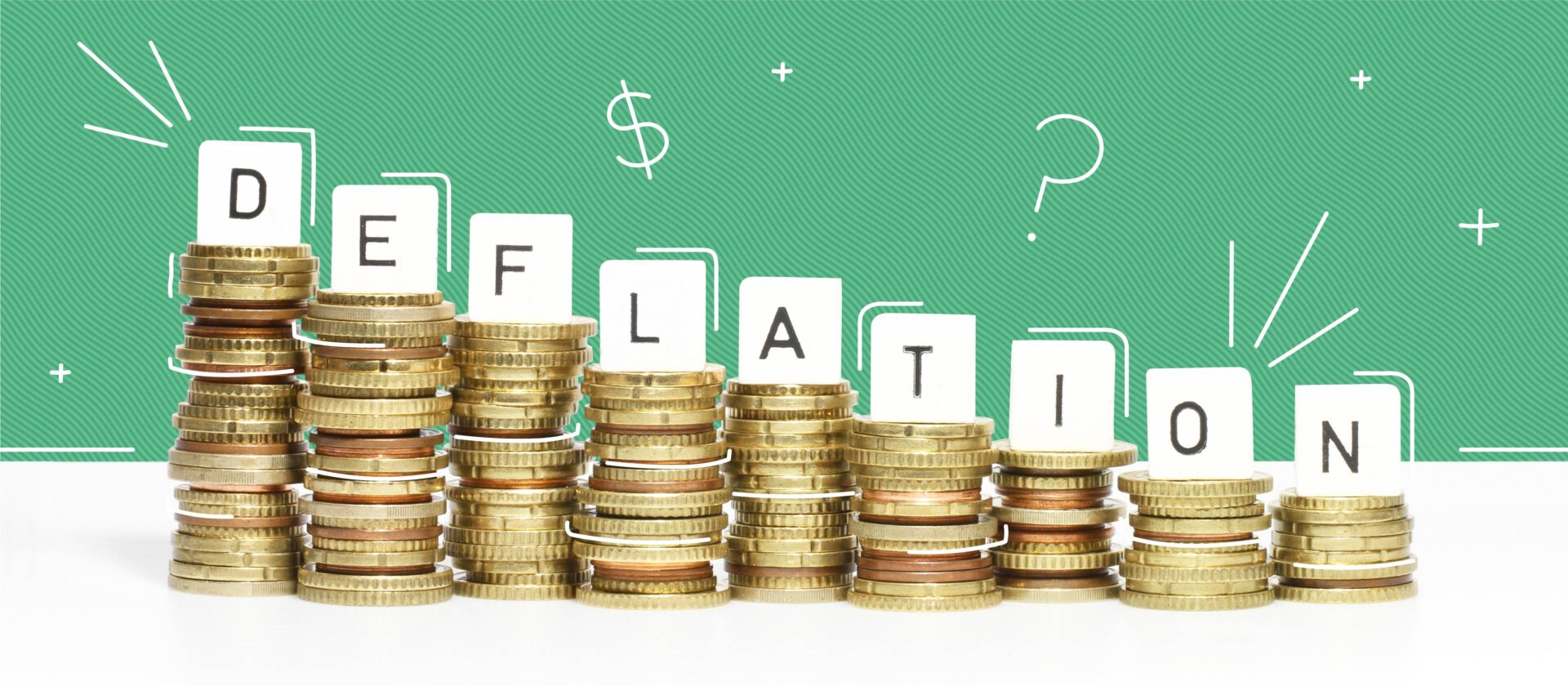What Is Deflation?
Deflation is a general decline in prices for goods and services, typically associated with a contraction in the supply of money and credit in the economy. During deflation, the purchasing power of currency rises over time.

KEY TAKEAWAYS
- Deflation is the general decline in the price level of goods and services.
- Deflation is usually associated with a contraction in money supply and credit supply, but prices can also fall due to increased productivity and technological improvements.
- Whether the economy, price level, and money supply deflate or inflate changes the appeal of different investment options.
Deflation Explained in simple terms.
Understanding Deflation
Deflation causes the nominal costs of capital, labor, goods, and services to fall, though their relative prices may be unchanged. Deflation has been a widespread concern among economists for decades. Deflation benefits consumers because they can purchase more goods and services with the same nominal income over time.
However, not everyone wins from lower prices, and economists are often concerned about the consequences of falling prices on various sectors of the economy, especially in financial matters. In particular, deflation can harm borrowers, who can be bound to pay their debts in money worth more than the money they borrowed, and any financial market participants who invest or speculate on the prospect of rising prices.
Causes of Deflation
By definition, monetary deflation can only be caused by a decrease in the money supply or financial instruments redeemable in cash. In modern times, the money supply is most influenced by central banks, such as the Federal Reserve. When the supply of money and credit falls, the prices of all goods tend to fall without a corresponding decrease in economic output. Periods of deflation most commonly occur after long periods of artificial monetary expansion. The early 1930s was the last time significant deflation was experienced in the United States. The major contributor to this deflationary period was the fall in the money supply following catastrophic bank failures. Other nations, such as Japan in the 1990s, have experienced deflation in modern times.
World-renowned economist Milton Friedman argued that under the optimal policy, in which the central bank seeks a deflation rate equal to the real interest rate on government bonds, the nominal rate should be zero, and the price level should fall steadily at the actual rate of interest. His theory birthed the Friedman rule, a monetary policy rule.
However, declining prices can be caused by several other factors: a decline in aggregate demand (a decrease in the total demand for goods and services) and increased productivity. A reduction in aggregate demand typically results in subsequent lower prices. Causes of this shift include reduced government spending, stock market failure, consumer desire to increase savings, and tightening monetary policies (higher interest rates).
Falling prices can also happen naturally when the economy’s output grows faster than the supply of circulating money and credit. This occurs significantly when technology advances the productivity of an economy and is often concentrated in goods and industries which benefit from technological improvements. Companies operate more efficiently as technology advances. These operational improvements lead to lower production costs and cost savings transferred to consumers through lower prices. This is distinct from but similar to general price deflation, which is a general decrease in the price level and an increase in the purchasing power of money.
Price deflation through increased productivity is different in specific industries. For example, consider how increased productivity affects the technology sector. In the last few decades, improvements in technology have resulted in significant reductions in the average cost per gigabyte of data. In 1980, the average cost of one gigabyte of data was $437,500; by 2014, the average cost was three cents. This reduction also caused the prices of manufactured products that use this technology to fall significantly.
Changing Views on Deflation’s Impact
Following the Great Depression, when monetary deflation coincided with high unemployment and rising defaults, most economists believed deflation was an adverse phenomenon. After that, most central banks adjusted monetary policy to promote consistent increases in the money supply, even if it promoted chronic price inflation and encouraged debtors to borrow too much.
British economist John Maynard Keynes cautioned against deflation as he believed it contributed to the downward cycle of economic pessimism during recessions when owners of assets saw their asset prices fall and so cut back on their willingness to invest. Economist Irving Fisher developed an entire theory for economic depressions based on debt deflation. Fisher argued that the liquidation of debts after a negative economic shock could induce a more significant reduction in the supply of credit in the economy, which can lead to deflation which in turn puts even more pressure on debtors, leading to even more liquidations and spiraling into a depression.
In recent times, economists have increasingly challenged the old interpretations of deflation, especially after the 2004 study by economists Andrew Atkeson and Patrick Kehoe. After reviewing 17 countries across 180 years, Atkeson and Kehoe found 65 out of 73 deflation episodes with no economic downturn, while 21 out of 29 depressions had no deflation. Now, many opinions exist on the usefulness of deflation and price deflation.
Deflation Changes Debt and Equity Financing
Deflation makes it less economical for governments, businesses, and consumers to use debt financing. However, deflation increases the economic power of savings-based equity financing.
From an investor’s point of view, companies that accumulate large cash reserves or have relatively little debt are more attractive under deflation. The opposite is true of highly indebted businesses with little cash holdings. Deflation also encourages rising yields and increases the necessary risk premium on securities.












